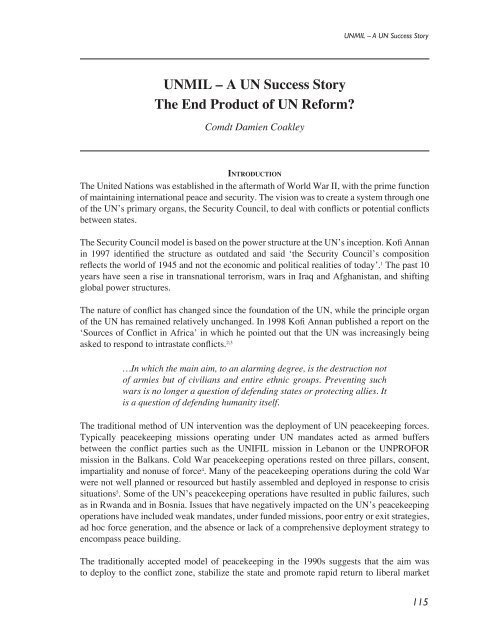Defence Forces Review 2008
Defence Forces Review 2008
Defence Forces Review 2008
Create successful ePaper yourself
Turn your PDF publications into a flip-book with our unique Google optimized e-Paper software.
UNMIL – A UN Success Story<br />
UNMIL – A UN Success Story<br />
The End Product of UN Reform<br />
Comdt Damien Coakley<br />
In t r o d u c t i o n<br />
The United Nations was established in the aftermath of World War II, with the prime function<br />
of maintaining international peace and security. The vision was to create a system through one<br />
of the UN’s primary organs, the Security Council, to deal with conflicts or potential conflicts<br />
between states.<br />
The Security Council model is based on the power structure at the UN’s inception. Kofi Annan<br />
in 1997 identified the structure as outdated and said ‘the Security Council’s composition<br />
reflects the world of 1945 and not the economic and political realities of today’. 1 The past 10<br />
years have seen a rise in transnational terrorism, wars in Iraq and Afghanistan, and shifting<br />
global power structures.<br />
The nature of conflict has changed since the foundation of the UN, while the principle organ<br />
of the UN has remained relatively unchanged. In 1998 Kofi Annan published a report on the<br />
‘Sources of Conflict in Africa’ in which he pointed out that the UN was increasingly being<br />
asked to respond to intrastate conflicts. 2;3<br />
…In which the main aim, to an alarming degree, is the destruction not<br />
of armies but of civilians and entire ethnic groups. Preventing such<br />
wars is no longer a question of defending states or protecting allies. It<br />
is a question of defending humanity itself.<br />
The traditional method of UN intervention was the deployment of UN peacekeeping forces.<br />
Typically peacekeeping missions operating under UN mandates acted as armed buffers<br />
between the conflict parties such as the UNIFIL mission in Lebanon or the UNPROFOR<br />
mission in the Balkans. Cold War peacekeeping operations rested on three pillars, consent,<br />
impartiality and nonuse of force 4 . Many of the peacekeeping operations during the cold War<br />
were not well planned or resourced but hastily assembled and deployed in response to crisis<br />
situations 5 . Some of the UN’s peacekeeping operations have resulted in public failures, such<br />
as in Rwanda and in Bosnia. Issues that have negatively impacted on the UN’s peacekeeping<br />
operations have included weak mandates, under funded missions, poor entry or exit strategies,<br />
ad hoc force generation, and the absence or lack of a comprehensive deployment strategy to<br />
encompass peace building.<br />
The traditionally accepted model of peacekeeping in the 1990s suggests that the aim was<br />
to deploy to the conflict zone, stabilize the state and promote rapid return to liberal market<br />
115
















